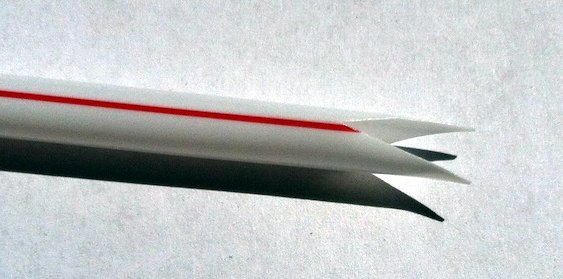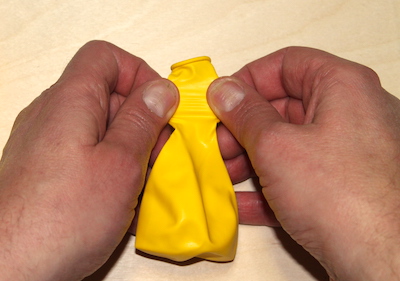A Toy Oboe
How to make an oboe from a soda straw, and annoy your family while you learn about reed instruments
I usually introduced this one just by telling students that we were going to make a craft project. We spent about 5 minutes snipping at soda straws, and then I showed them how you can make the straws squeal by blowing into them, and the students had a blast. At the end, we discussed how oboes and saxophones work in the same way as their soda straws. What they made was essentially a soda-straw oboe.
To make a soda-straw oboe, you simply cut a pair of “reeds” into one end: Flatten one end and crease the sides as best you can, then snip away the corners, making two pointy triangular flaps, like this:

The exact size and shape of the flaps isn't critical, but they should be reasonably symmetric and not too short. They should be maybe 1½ to 2 times longer than they are wide. Also, I have found that some brands of straw work better than others. The plastic in some straws is a little more resilient and harder to crease, and those straws don't work as well.
To play the oboe, you place the reeds inside your mouth and pretend you are biting down on the base of a duck's bill. With your teeth or your lips, press the bases of the two flaps close together, and then blow as hard as you can. Depending on the flexibility of the plastic, and on how you shape your mouth, you may be able to produce a variety of squawks and squeals.
When I would try this activity with my classes, there would often be a few forlorn children unable to produce the sounds and to have all the fun that everyone else was having. I can't guarantee that every child will learn how to make the noise, but I can offer a few tips:
- Children often make their flaps or "reeds" too short and stubby, in which case they probably won't vibrate well. The triangular reeds should be longer than they are wide. The shape shown in the photo usually works well for me.
- You need to clamp down on the base of the reeds with your mouth to flatten out the end of the straw, but the reeds themselves still need to be free to vibrate inside your mouth. Sometimes children will clamp down on the reeds themselves, and prevent them from vibrating. They might need to insert the straw a little farther into their mouths.
- To make the oboe sound, you need to blow pretty hard. Sometimes just telling children to blow as hard as they can works. Another suggestion that sometimes helps is to clamp down all the way, closing the straw completely, then try to blow as hard as you can to build up air pressure, and then very gradually release your grip on the straw until a tiny stream of air can get out.
In my experience, the novelty of noise-makers wears off pretty quickly unless you can actually play different notes. How can we make our straw oboes play different notes? I have tried fitting a second, ever-so-slightly larger straw over the first, and making a “slide-oboe”, but the two straws have to be very close-fitting or it doesn't work. I (and my students) have also tried snipping holes into the sides of the straw. We can't play recognizable melodies, be we can at least make different notes come out by uncovering one or the other of the holes. (It is only the closest opening to the mouthpiece that matters, so it doesn't do much good to leave them all uncovered and only cover up one at a time. You have to cover them all, and then uncover them one at a time.)
If you wish to demonstrate how actual reed instruments work, you probably don't want to buy an entire saxophone just for a science demonstration. However, you can buy a saxophone mouthpiece for only a few dollars, from Amazon or from your local music supply store. It isn't too hard to learn how to make it squawk all by itself, or you can attach it to a length of garden hose or a hollowed-out carrot, as Linsey Pollak has done.
Nature's Reed Instruments
By the way, how does your own voice work? Try resting your fingertips gently against the lump in your throat (also called your “larynx” or “voice box”) while you whisper. Then turn on your outdoor voice and start speaking or singing. You may notice that your voice box “buzzes” or vibrates when you are speaking, but not when you are whispering. There is something in your throat that seems to work like the reeds in a reed instrument. When you “activate” them, they vibrate and resonate and make your voice much more powerful. If you were to look inside a voice box, you would find a couple of thin sheets of “rubber fabric” that come together and almost close off your windpipe when you turn on your voice. These flaps are like reeds in your throat, and you can turn them on whenever you want to make a loud voice. (We call these flaps or “reeds” in your throat your “vocal cords.”)
Another way to make a fun (or annoying) reed instrument, one that resembles your vocal cords, is to pinch the neck of a balloon. The neck of a balloon is normally loose and floppy and air can flow through without too much trouble, but if you pinch and stretch the sides, you can make two “flaps” that come together and close the opening, like your vocal cords.

If you do this to an inflated balloon, the balloon will try to “exhale” through the pinched neck, won't it? The balloon will be just like your lungs when you breathe out, the neck of the balloon will be like your windpipe, and the stretched “flaps” between your fingertips will be like your vocal cords, won't they? What do you suppose that would sound like? Do you suppose you could make it “speak” in different tones?